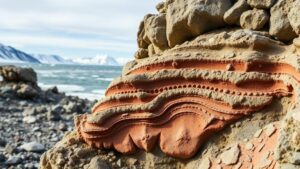Petrified Rivers: Tracing Fossilized Flow Patterns in Ancient Floodplains
Petrified Rivers: Tracing Fossilized Flow Patterns in Ancient Floodplains
For rockhounds and mineral collectors, the allure of natures artistry is undeniable. Among the most fascinating geological phenomena are petrified rivers–ancient waterways turned to stone, offering a glimpse into Earths environmental history. This article delves into the formation, significance, and collection of petrified rivers, presenting enthusiasts with the knowledge to explore this captivating aspect of geology.
The Formation of Petrified Rivers
Petrified rivers are a type of fossilization process known as permineralization, where organic material, such as wood or sediment, is replaced by minerals over time. This process typically occurs in areas that have experienced significant geological changes, where sedimentation and volcanic activity are prominent.
The main factors leading to the formation of petrified rivers include:
- Volcanic Activity: Ash from nearby volcanic eruptions can bury timber or organic materials, preserving them under layers of sediment.
- Mineral Infusion: Mineral-rich water seeps through the organic material, depositing minerals like silica, calcite, or pyrite into the cellular structure.
- Time: It can take thousands to millions of years for complete petrification to occur, allowing ample time for the surrounding environmental conditions to play their role.
The result is an intricate representation of ancient waterways, often including preserved root structures, barks, and even fine details that tell the story of the environment long gone.
Sediments from petrified rivers hold significant insights into the conditions that existed in the past. For example, studies of these ancient ecosystems allow scientists to gather valuable data related to ancient climates and biodiversity. Here are key takeaways:
- Climate Records: Examining the flow patterns of petrified rivers can provide data on past climatic conditions, indicating whether the area was once arid or lush.
- Biodiversity Insights: Fossilized remains found in these formations help reconstruct the ecosystems that existed, shining a light on the types of flora and fauna that thrived.
- Geological Indicators: The chemical composition of the minerals can reveal information about the historical geology of regions, guiding explorations for fossil fuels and other geological resources.
Collecting Petrified River Samples
For mineral collectors, acquiring petrified river samples can be a rewarding endeavor. But, there are certain considerations and practices to keep in mind:
- Research Location: Certain regions are renowned for their petrified wood and river formations, such as the Petrified Forest National Park in Arizona. Always check local regulations regarding collection to avoid legal issues.
- Considerations on Size: Large samples might be impractical to transport. A piece around 2-3 inches in diameter is often ideal for collectors with limited space.
- Quality Over Quantity: Look for pieces that showcase intricate flow patterns or unique mineral features such as iridescence or banding.
Engaging with local rockhounding clubs or participating in guided tours can enhance the collecting experience, providing valuable knowledge and safe exploration practices.
Real-World Applications
Petrified rivers not only attract collectors but also have applications in education and industry. serve as teaching tools in geology classes, illustrating sedimentary processes and fossilization. Plus, the aesthetic appeal of petrified wood and river formations has led to their use in art, furniture, and home decor.
Conclusion
Petrified rivers symbolize the confluence of art and science, embodying history within their mineralized structures. For rockhounds and mineral collectors, they offer adventure, education, and the thrill of discovery. By understanding their formation, significance, and the best practices for collection, enthusiasts can deepen their connection with Earths geological wonders. Whether starting a collection or expanding an existing one, petrified rivers are a spectacular testament to natural history waiting to be explored.



